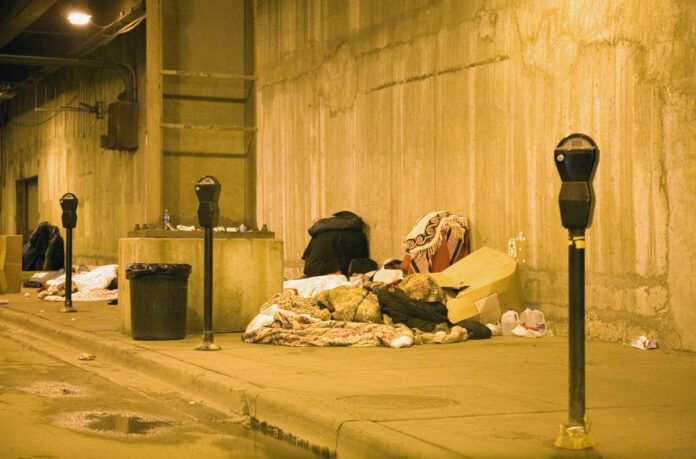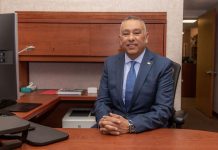A group of about 12 San Diegans are choosing to sleep outside with nonprofit San Diego Youth Services Oct. 7 to raise awareness of youth homelessness and fund programs that might change the outcome for over 1,800 children who sleep on county streets every night.
SDYS Chief Executive Officer Walter Philips said the approach is not intended to replicate what homeless youth encounter each night but to raise awareness of an issue which he said has remained under the radar.
“Homelessness has been an issue in San Diego for a long time but youth really only started getting attention in the last five or six years. They aren’t pushing a shopping cart, they’re anywhere from 12 to 24 years old. They look like other kids, they’re carrying a backpack. Maybe you see a group of teens all playing basketball and when they all disperse, one doesn’t have anywhere to go,” Philips said.
There are identifiable risk factors, he said: a dysfunctional family dynamic, poverty, abuse at home that leads to a runaway situation. There is a “huge percentage of LGBTQ+ youth who don’t feel safe when they come out and go couch surfing or bounce around homes,” Philips said, as well as a high percentage of ethnically diverse youth evident in the juvenile justice system.
Youth— which he said includes young adults who are navigating early life choices— don’t tend to access systems that have been put in place for adults because they don’t feel safe or comfortable so SDYS conducts most of its outreach through youth providers.
“Three to five years ago there was very little funding for that population. The state was providing about one million dollars across the entire state- it was appallingly little funding and the state but thankfully the county has really stepped up the amount of resources for youth services,” Philips said.
About 22% of the homeless count are considered youth but only about 10% of the state’s homeless outreach funding goes to their cohort, Philips said, a situation he said leaves vulnerable youth at risk for chronic homelessness as they grow into adulthood.
“I really liked a quote from Father Joe which basically said we’re in competition with the pimps and the drug dealers and the predators for the young people when they hit the streets. There’s sexual exploitation, higher rates of drug use just waiting for them— if we don’t intervene what are the consequences?” Philips asked.
However, youth homelessness doesn’t start with bouncing around couches, he said, and changing that outcome starts with sucicide prevention training in schools, diverting early offenders to keep kids out of the juvenile justice system, having homeless liaisons in schools, addressing food insecurity and family struggles with housing.
In South County, the group leans on partnerships that go out into local communities.
“SBCS, which used to be South Bay Community Services, they’re a great partner and we work with them on outreach teams that go from our agency into the community, and into schools to address the issue. We’re pretty much back at full strength since COVID. We also partner with YMCA, Home Start, Urban Street Angels,” Philips said, all agencies that approach solving youth homelessness through early intervention, as well as the Regional Task Force on Homelessness and the county government.
Meanwhile, in East county, the organization performs outreach through local schools.
“We work a lot in East county school districts— one thing changing for the better is recognizing the problem begins locally. There was the idea that homeless are coming from other regions but a survey from a few years back showed most of the homeless in East County were from there, not coming from other places. We’ve had success with some school districts in the community realizing their communities are at risk and we need to bring in resources,” Philips said.
Young adults who have aged out of high school have been disproportionately affected by the high cost of housing across the county, Philips said, as they are less able to compete for housing.
“Typically, those young people don’t have high education levels or a lengthy work history and they’re making minimum wage, they’ve often made poor choices and don’t have a good credit history. Basic things many people take for granted like filling out a housing application and getting on a waiting list is harder for them. And, another barrier is really, there is just not enough affordable housing,” Philips said.
To help those older youth who are aging into true adulthood, Philips said, they have acquired between 110 and 130 units to provide a continuum of housing from shelter beds. As more affordable housing is built in the county, he said, advocates have to make sure some space is carved out for young people.
The Street Sleep event is specifically designed to raise awareness of risk factors, what can be done to prevent homelessness in at-risk youth and what can be done to end it for others.
“I really want to emphasize we’re not trying to pretend we’re homeless, we’re just trying to raise awareness for struggling youth. We get to get up and go back to our homes and beds,” Philips said.
Visit www.streetsleepsd.blackbaud-sites.com for more information on the event.
In a previous version of this story Walter Philips was misquoted as saying “The state was providing about a billion dollars across the entire state- it was appallingly little funding and the state but thankfully the county has really stepped up the amount of resources for youth services.”
Philips actually said: “The state was providing about a million dollars across the entire state- it was appallingly little funding from the state but thankfully the county has really stepped up the amount of resources for youth services.”
The Star-News regrets the error.















